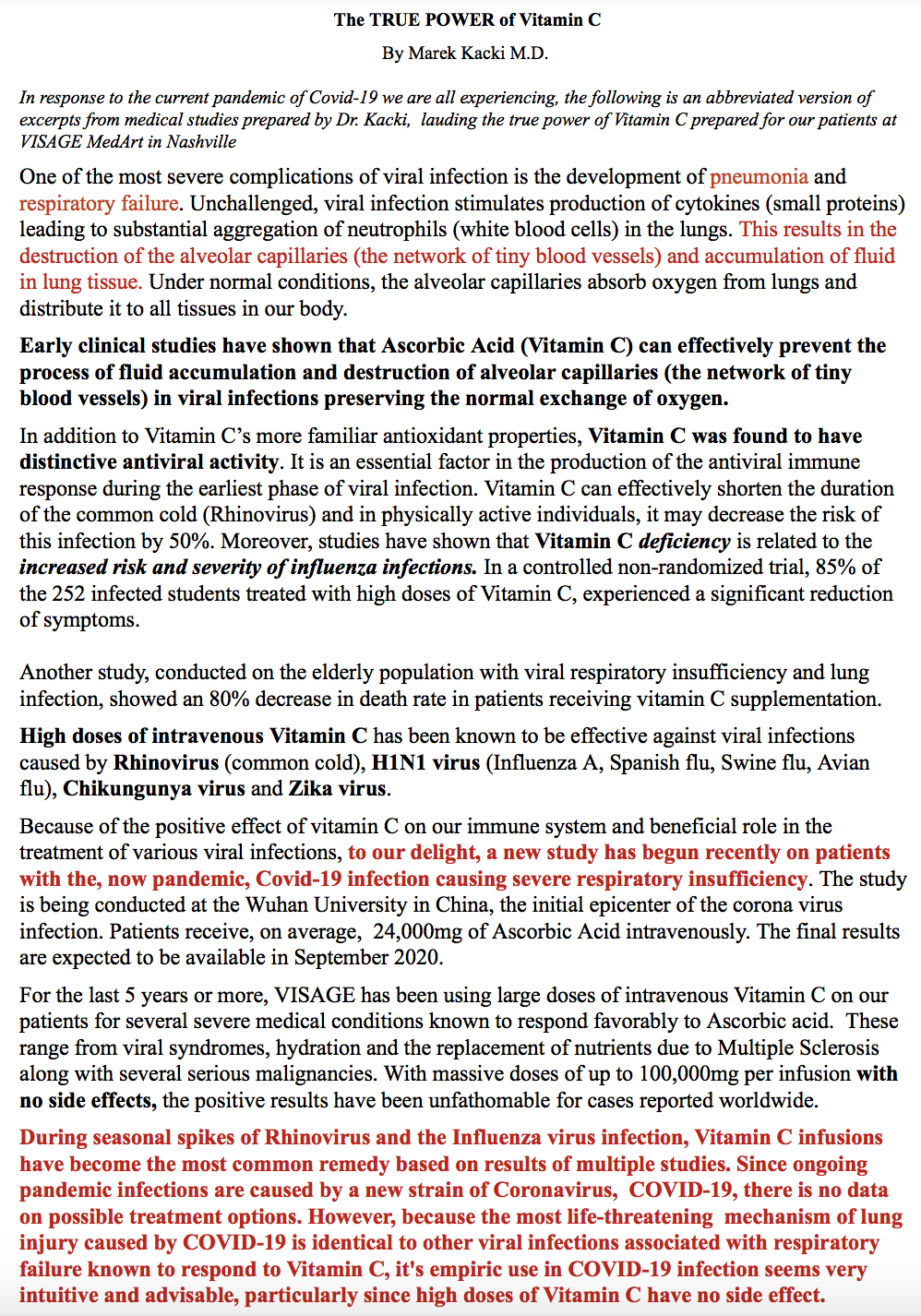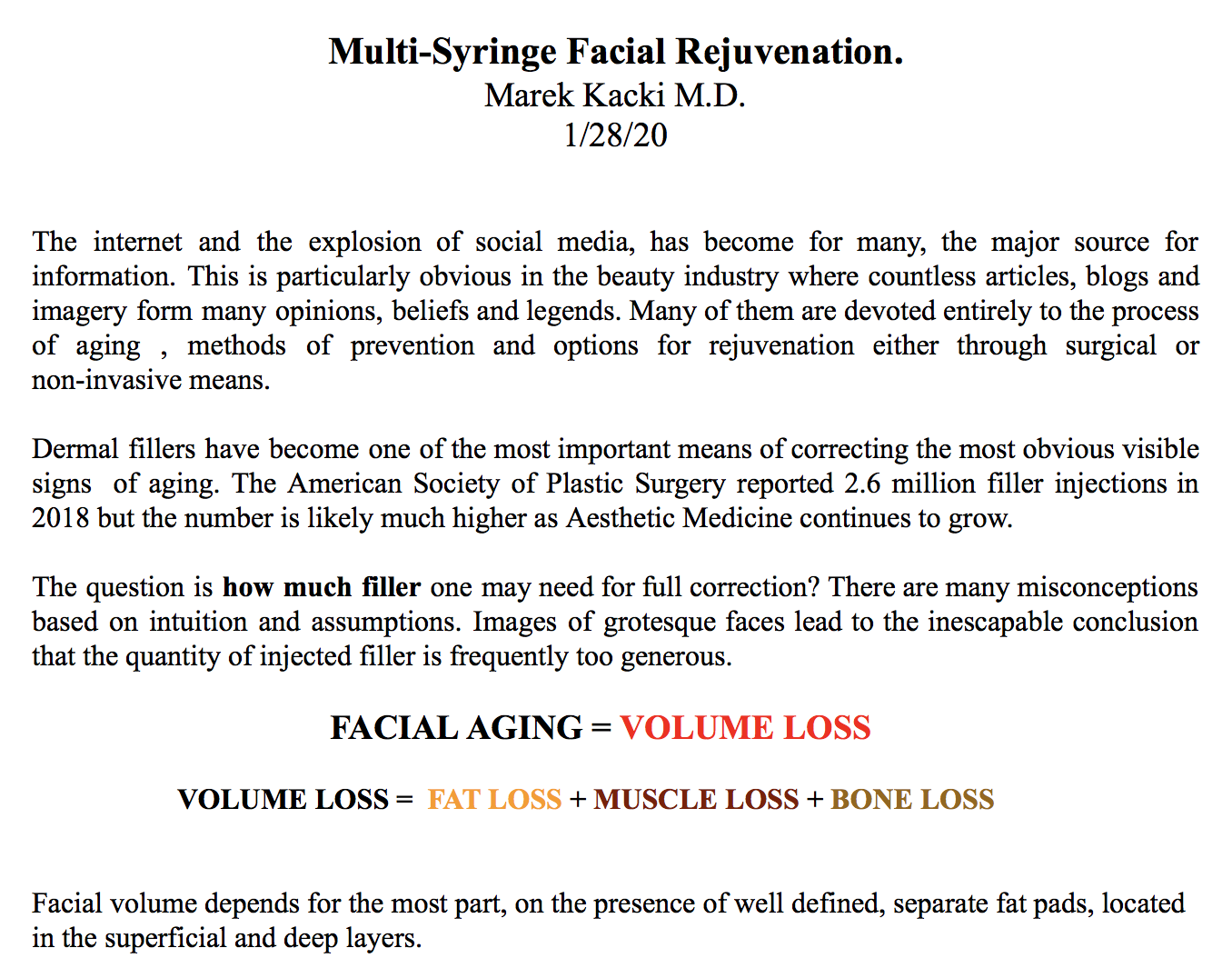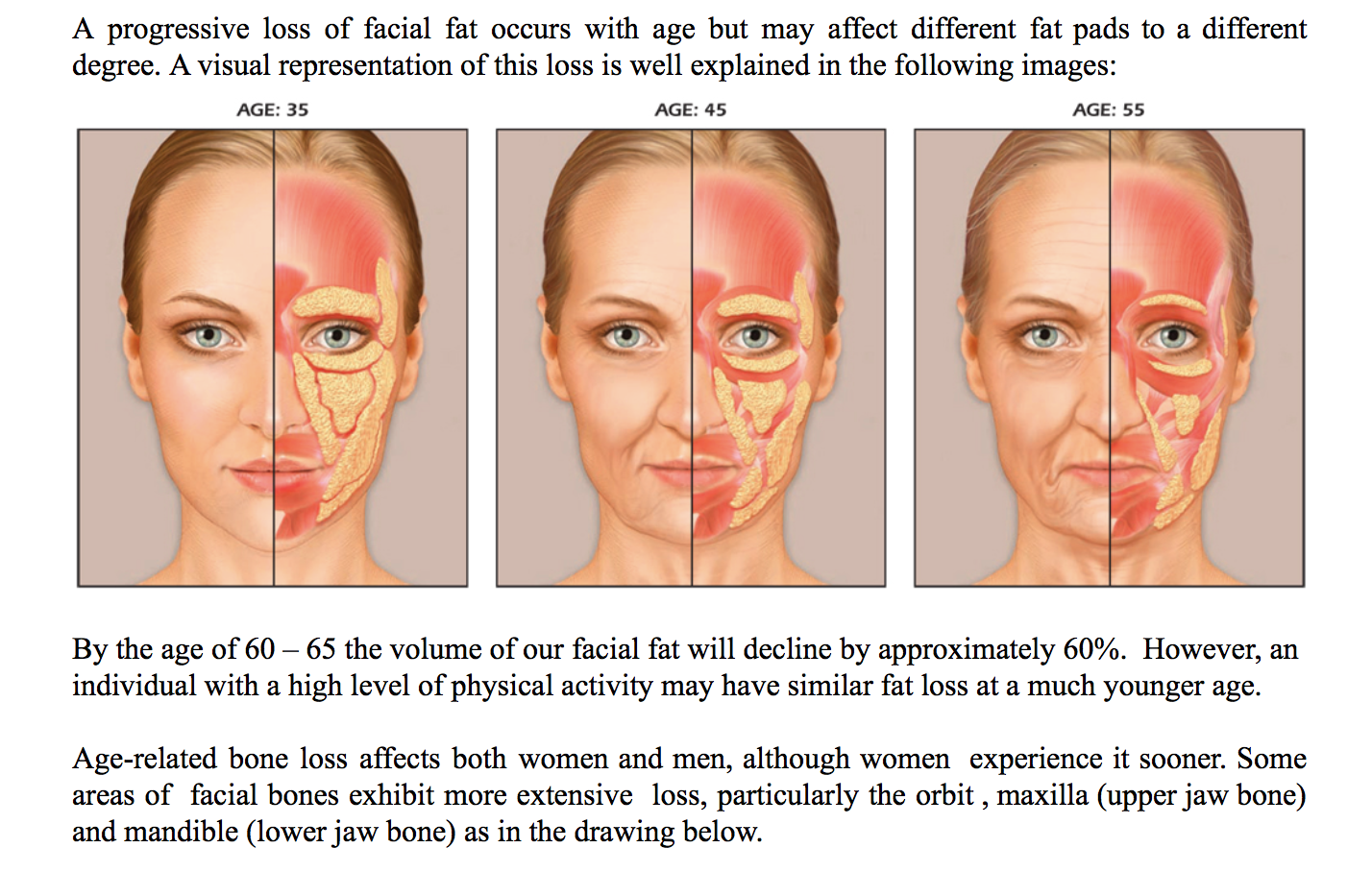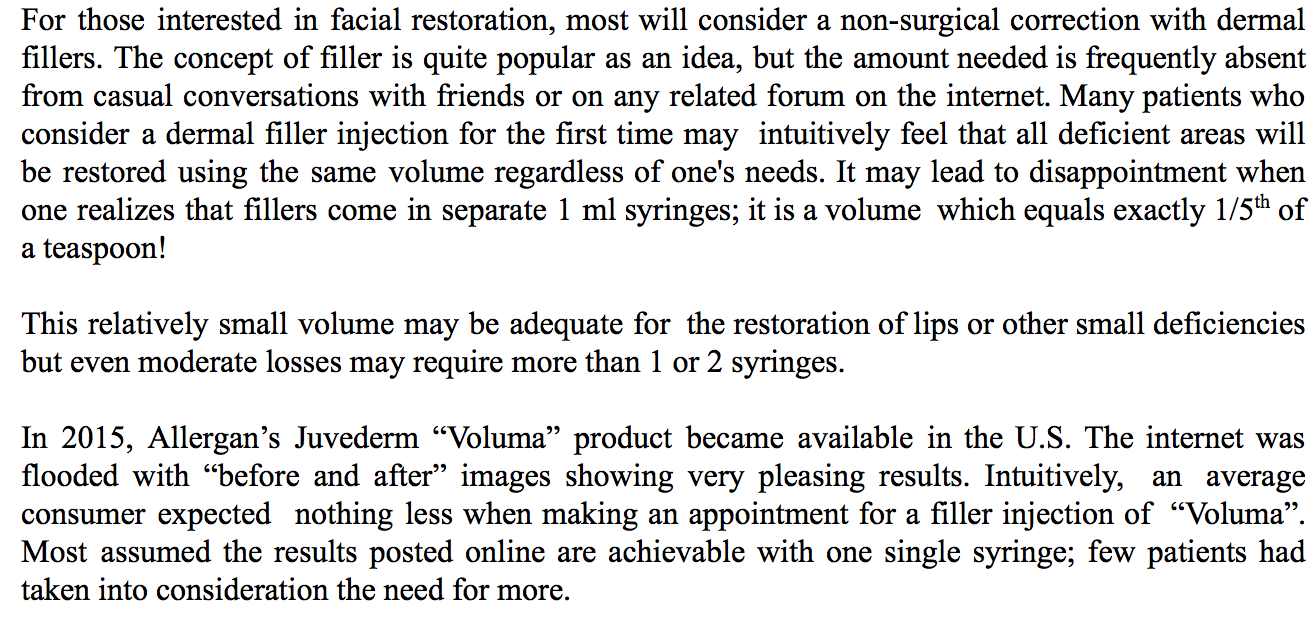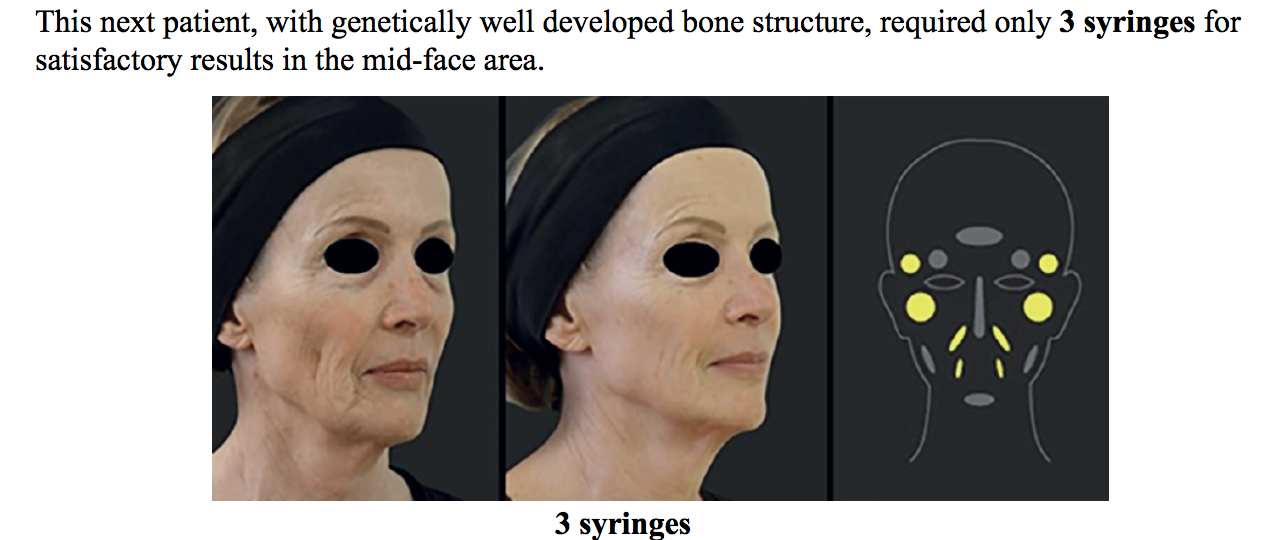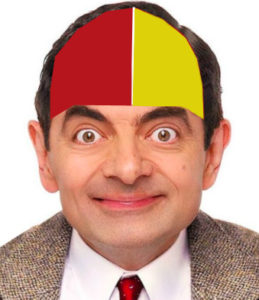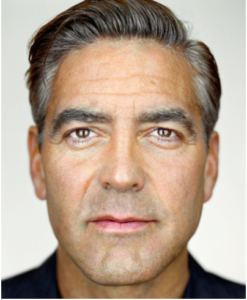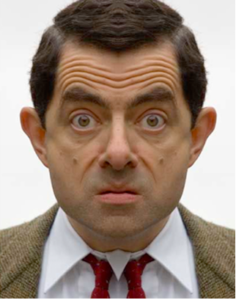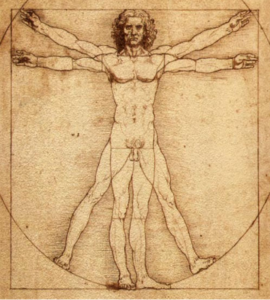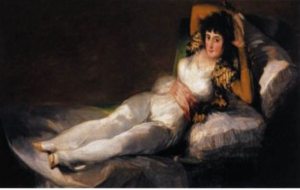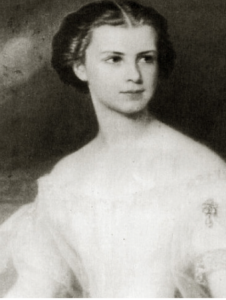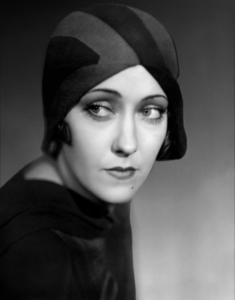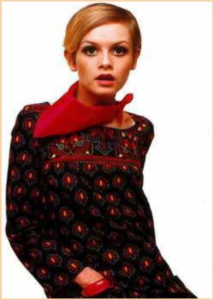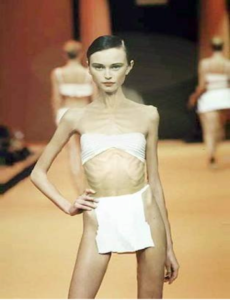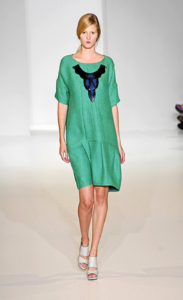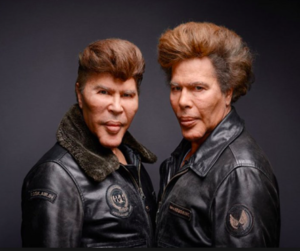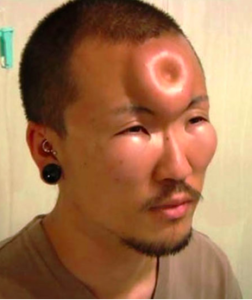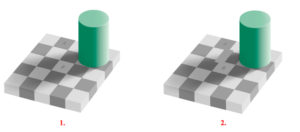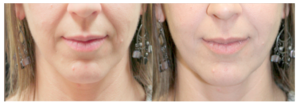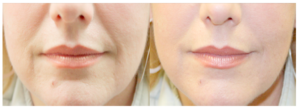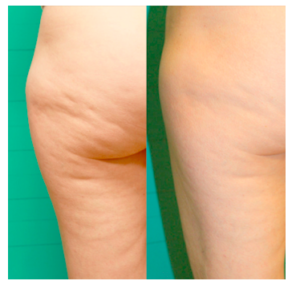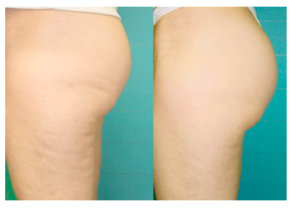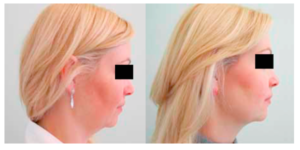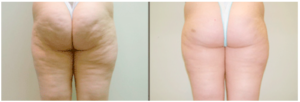Facial Aesthetics – The Myth of Symmetry
/in Blog & Updates /by CThe concept of facial symmetry has become the main guiding principle of Cosmetic Medicine absorbed by many patients seeking aesthetic services. Establishing facial symmetry by all available means is being assumed to represent the path to absolute beauty and stamp of practitioner’s skills. Very few doctors, however, are aware of the true concepts of beauty and its representation in reality as evidenced by their continuous referral to the “Golden Rule” principles as the only learned option. In reality, however, what matters is not a particular number, eg. 1.6 in the Golden Ratio, but a concept that is much deeper and universal, a concept known since the beginning namely, the directional symmetry or antisymmetry.
The intuitive desire for symmetry and its indiscriminate implementation in facial aesthetics does not serve well most of the patients. An obsession with symmetrical “perfection” turns out quite disappointing and plain with features lacking originality. Consequently, many patients end up looking very similar with predictable traits of adjustments. The flaws of newly created symmetry may not be instantly obvious to many unless you look at the images before the changes were made. In reality, most of the natural asymmetry is an asset not to be disposed of.
Extensive research carried out in late 1800’s revealed that asymmetry is almost universal in human body, including head, particularly the face. Asymmetry of the head is manifested in various ways. Some typical examples are:
the left half of the cerebral part of the cranium is smaller than the right
the left side of the face is wider than the right
the right side of the face is longer than the left
the nose is not in the vertical midline
the tip of the nose is displaced to one side
There are many other asymmetries related to the structure of our skulls that make distances between the corresponding parts different on each side such as the distance between the outer corner of the eye and the corner of the mouth is not the same on both sides of the face or the left eye is closer to the vertical midline.
THE SYMMETRY OF THE HEAD MUST BE REGARDED AS A FEATURE TAHT IS CHARACTERISTIC OF
HUMAN BEINGS WHATEVER THEIR RACE OR A PERIOD TO WHICH THEY BELONG
Studies by Hasse in 1800’s showed that facial asymmetry is clearly an essential part of Greek art that pioneered the concept of classic beauty with proportions thought to be based on mathematical principles. Venus de Milo, one of the most famous sculpture represents certain aspects of Hellenistic art combined with earlier ideas of the Classical style. Hasse’s findings show that the main features of her beautiful face defy the purist, those who defined this style as a perfect balance based of symmetry. At the time of his detailed evaluation of Venous face he performed the same measurements on his co-workers at his institute. To his surprise, all his subjects revealed exactly the same asymmetries as the main object of his study.
At the first glance, it appears that Venus’ face is perfectly symmetrical and that the symmetry brings an absolute balance to her face. Yet, on closer examination, if one measures her face using a simple grid it becomes evident that only the lower part of the face, her lips and chin, is symmetrical.
Venus de Milo, face
The parts in mid and upper face are asymmetrical on both sides, the nose is shifted to the right from the midline, the left ear sitting higher than the the right and the line connecting both pupils is not truly horizontal.
NONE OF THE ADULT BODY PARTS IS FORMED STRICTLY SYMMETRICAL
Many investigations and studies of the relationship between asymmetry and facial attractiveness have shown that “correction” of asymmetry creates “averageness” and perception of diminished natural beauty. Contrary to what some predicted, faces that were made more symmetrical were perceived as being less attractive, unemotional, predictable, and with sterile rigidity .
Here are few examples of asymmetry in well known faces. Compare George Cloony‘s real image on the left with images representing his face in total symmetry. These were created my making a mirror image of each side. The perfectly symmetrical features on image 2 and 3 lack character innate to his real face; both symmetrical images are predictable, boring and do not attract attention for more than a casual glance.
George Clooney
1 2 3
David Bowie with his very original physique becomes much less interesting if his features are subjected to symmetry. His distinctive brows, eyes, mouth and the outline of his face are lost along with his uniqness and character on the images 2 and 3 when absolute symmetry is created.
David Bowie
1 2 3
And my dear friend, Mr. Bean, may serve as a great example. When his face is made symmetrical on the images 2 and 3, it becomes dull, much less interesting and appear to be computer generated . Only his natural face holds larger than life diversity and brings about particular emotions created by his asymmetrical jawline and obviously larger left side of his face.
Rowan Atkinson – “Mr. Bean”
1 2 3
In summary, the natural facial asymmetry is, most of the time, a gift of nature giving us our distinctive appearance, uniqueness and enigma. Trying to establish a symmetry takes away our most important facial features and brings predictability and averageness; the face becomes one of many replicas.
In the comments of many cosmetic doctors the asymmetry is considered a must and the Golden Ratio a gospel. Many make a reference given to the “Marquardt mask”, or Golden Ratio mask. The mask is a grid that, if superimposed on the photograph of a face, will perfectly fit only a “perfect” face while revealing flaws of the “common” faces. Very few are aware, however, that the mask has significant design flaws and was discredited as a tool for aesthetics. Not only it fit perfectly many “common” faces and disregarded ethnic differences but it’s design was based on perfect facial symmetry and modeled on a very small, non-representative, population.
There are many patients who discover their asymmetry at certain stage of facial aging, the asymmetry that was there all along but not noticeable. With progressive facial volume loss the unnoticeable before asymmetry becomes more and more apparent with passing time. To address those concerns one must carefully approach the propose enhancements while resisting the idea of perfect symmetry that was never there. Otherwise, the results will be predictably unsatisfactory.
The key to any aesthetic enhancement lies in maintaining your natural beauty rather than attempting to create a perfect mask. To accomplish that, the manual skills are not enough; what is required is an understanding of spatial relationships between all elements and one’s individuality. Its a difference between the craft and art.
The History of Feminine Beauty
/in Blog & Updates /by C(Very) Brief History of Feminine Beauty
FROM PRE-HISTORY, GREECE, MIDDLE AGES AND RENAISSANCE TO
IMPRESSIONISM, DIOR’S 40’S , REBELIOUS 60’S AND 2000’S.
PRE-HISTORIC TIMES
The perception of feminine beauty underwent profound metamorphosis many times during our history with many ideals appearing and disappearing cyclically.
The earliest known expressions of feminine beauty are contained in figurines, collectively called Venus, that are dated back to the European Ice Age approximately 25,000 years ago.
Venus of Villendorf Venus of Dolni Vestonice Venus of Lespugue
Coming from different areas of the World, these examples may suggest a fascination with certain attributes of femininity rather than simple expression of uniform beauty. All are characterized by the absence of face and feet making them more symbolic rather than personal.
The figurines certainly do not conform very much to our present sense of an ideal body; it is believed these images represent a homage to fertility and ability to survive under harsh conditions. The accumulation of fat may be seen as a means of storing energy when expected external sources were beyond the reach.
ANCIENT EGYPT
The artifacts from Egypt reveal dramatic change in the interpretation of human beauty, perfectly represented in relief made over 3,500 years ago and depicting Tut-anch-Amun an his wife Anch-es-Amun.
Fragment of Ivory Chest

The image shows an unique and refined fashion, delicate and slim female body. Women were shaved entirely, frequently including heads, and to emphasize this, their pleated skirts were worn wide open in front.
In Egypt, a beautiful face was considered to be one with fine features, large, expressive eyes and black hair. Long and graceful neck was complemented by a very slim body with fine wrists and ankles and long, delicate fingers. Queen Nefertiti limestone bust is regarded as an ancient icon of female beauty.
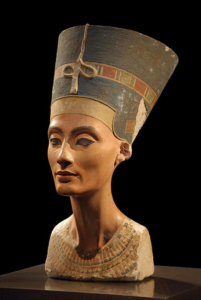
Nefertiti
ANCIENT GREECE
The concept of classical beauty, originated in Greece, is perfectly described in the architectural treatise of Vitruvus Pollio in the I century BC. It has profoundly influenced art throughout history. Beauty was based on symmetry, physical and mental harmony, balanced proportions and mathematical relationship of the parts to the whole, known as the Golden Section.
Vitruvian Man
This well known drawing by Leonardo da Vinci, about 1500, relates to Vitruvus Pollio’s only architectural treatise to survive from Antiquity. Although it is unillustrated, it profoundly influenced art throughout history, especially in the period Renaissance.
Socrates postulated, that the main task of the artist was to give a standard of idealized contour of the human body in exact proportions to gain Balance and Harmony. We can still admire this in the statue of the “Venus de Milo“, one of the most famous works of art history created around 100 BC. It became the symbol of classical female beauty with universal appeal where mathematical proportions produced, what was thought to be, a perfect Balance and Harmony.
Venus de Milo
Paradoxically, in contrast to the most perfect symmetry of bust of Nefertiti, Venus of Milo contains many intended facial asymmetries that are very difficult to notice unless one measures every detail or applies a grid.
The only symmetrical part is her lower face. Her nose is deviated to the left, left ear stands higher than the right and the left eye is higher and closer to midline than the right. These features of Venus prove the genius of Greek art and unsurpassed understanding of visual perception. This is a gift and absolute requirement for those who create art, from ancient sculptor to contemporary practician of Aesthetics. Perceptually, artist’s genius created perfectly balanced image without insisting on symmetry.
MIDDLE AGES
In the early Middle Ages dominated by the Christian faith, excessive care of the body or the application of make-up were unthinkable linking feminine beauty with danger and sin that led to the epulsion from Paradise caused by Eve. The proportions and harmony became unimportant and women were presented as plain, unattractive figures. And yet there was an ideal of feminine beauty, dominated by a delicate, white skin. Regular blood letting ensured a pale complexion, and toxic white lead was even used to lighten the color of the skin.
Adam and Eve, Grandval Bible, 840
After centuries of neglect, the late Middle Ages brought us many changes in representation of feminine beauty with a “Soft Style”, returning to luxurious, refined fashion and a slim silhouette.
RENAISSANCE
In Renaissance, the Ancient Greek culture and ideals of beauty were rediscovered and became part of everyday life. The classical antique style with symmetry and proportions were revived with women’s bodies being depicted more voluptuously with graceful arms and legs and delicate porcelain complexion emphasized with make-up.

Birth of Venus, Sandro Botticelli,1486
The attention was redirected from religious to the worldly themes for the first time since Hellenistic era of Ancient Rome. The ideals of Humanism were personified in the 1505 painting of Giorgione “Sleeping Venus” which had profound influence until modern times.
Sleeping Venus, Giorgione, 1505
BAROQUE
Baroque’s ideal of beauty brought the proverbial voluptuous female body. A typical Baroque splendour depicted here in 1646 “Wife of King Kandaules” by Jacob Jordaens, contemporary of Rubens. And like Rubens, the stout, luxuriant and round shape of femininity defined prevailing tastes.
The Wife of King Kandaules, Jacob Jordaens 1646
But, in late Baroque time , the Rococo, we see dramatic change in taste and perception of beauty. The ideal woman became slim, with tight waist and radiating grace. The figurines by Bustelli are prime examples of the new trend.

F.A. Bustelli, porcelain
EMPIRE
Empire era marks a full return to perfection and harmony of Ancient Greece that lasted through the next period of Classicism.
The Mayas, Francisco Goya 1798
Maya, the only nude painted by Goya, next to “Dressed Maya”, with a flowing silhouette is similar, in many ways, to the Renaissance composition of Giorgiones Venus.
ROMANTICISM
Romanticism and subsequent Victorian times reinforced the ideal of feminine beauty in slim, wasp-like waistline, fragile female body with small hands and feet . The Empress Elisabeth Eugenie Amalie von Wittelsbach, known as Sissi, was one of the most famous example of beautiful woman of this era.
Sissi
IMPRESSIONISM
The Impressionistic perception of beauty maintained a slim waist and re-discovered an old feature in new female silhouette, the “Parisian Bottom”, the emphasized buttocks absent from the canons of beauty for almost 2,000 years!
Bal at Moulin Rouge, Toulouse-Lautrec
This characteristic feature was casually depicted in Toulouse-Lautrec‘s painting “Ball at Moulin Rouge” .
XX century ideals of beauty underwent rapid and unexpected changes popularized and disseminated by a new vehicle, the MASS MEDIA .
ROARING 1920’s – EXPRESSIONISM
In the 20th century, the ideals of beauty begun to change with increasing speed. A new concepts of feminine beauty would transform visual tastes almost every single decade. Although there have been many reasons for these changes, the most critical has its root in development of imagery.
In the 20s, the early cinema begun creating its stars. Louise Brooks and Gloria Swanson defined female beauty: small head, expressive eyes, a fuller lips and short hair were the main features.
Louise Brooks Gloria Swanson
For the first time in history the sharp differences between sexes became less striking with feminine curves becoming less attractive.
1930’s
The decade of 1930′ brings Hollywood to the group of trend setters. The icon of Greta Garbo combined feminine beauty with mysterious sensuality, while Marlene Dietrich’s appearance in a man’s suit and tie was seen as an expression of bisexuality.
Greta Garbo Marlene Dietrich
1940’s
Christian Dior‘s fashions defined the ideal of beauty in the 40s: the slim, elegant woman with a ladylike charm. From that point on, fashion became a key ingredient is establishing new standards of marketable beauty.

From Dior’s collection
1950’s
In 50’s, Coco Chanel put an end to Dior’s “outdated” image of women. She focused primarily on the natural look, reflected in loosely draped fabrics, simple accessories and restrained make-up. Grace Kelly became world-famous for her cool beauty, while Gina Lollobrigida and Sophia Loren represented the temperamental beauty of the Mediterranean.
Grace Kelly Gina Lolobrigida Sophia Loren
REBELIOUS 60’s
1960’s brought massive social changes in western world including revolutionary perception of beauty. The British model Twiggy, the first model icon, set new standards of beauty with her slim bony figure that laid the foundations for the minimalist figure. “Slim” became synonymous with “Beautiful” in the eyes of society. The lips had a matt finish, but the eyes were emphasized with eyeliner. The fashion revolution of 60’s culminated with introduction of “mini” skirt by Mary Quant.
Twiggy Mini, Mary Quant
CRAZY 70’s
Narrow waists and splendidly voluminous hairstyles were the fashion in the 70s. Make-up was striking, yet kept in cool colors, and everyone wanted expressive eyes. Variations on this trend were the “gypsy look” and the “glitter look” à la Diana Ross.
Diana Ross
EXCESSIVE 80’s
The 80s became the era of emancipated career woman. Beauty was styled down to the last detail, decorated with striking colors and powerful, feminine make-up. This newest feminine silhouette, hardened by workouts and clear goals made a high-powered career woman to overcame every obstacle. Supermodels like Naomi Campbell or Linda Evangelista became admired ideals of beauty.
Naomi Campbell Linda Evangelista
INDIVIDUAL 90’s
In the 90s, individuality led to a much wider range of looks. Whether blond, brunette or black-haired – the ideal now means the beautiful individual faces which cannot be labeled in a single category.
Kate Moss starts the androgynous wave, with her girlish appearance.
Androgynous wave of 90’s
XXI CENTURY
In our times, beauty begins again to be closely associated with naturalness and individuality. It is no longer important to pursue an ideal from someone else; now, women are striving to show off their own advantages. Today, women are regarded as beautiful if they are charming, healthy, fit and powerful.
Yet, with advance of mass media, the self-proclaimed trend-setters have employed aggressive marketing and deceptive visualisation in order to force upon society an oppressive trend of pseudo-aesthetic “modern beauty” and not a realistic body image. “Thin” became new beautiful, desirable and even expected in fashion industry; soon it spilled over to the lives of many. Enter the world of anorexia.
SAD WORLD of ANOREXIA
There have been many personal tragedies and lives lost to anorexia, an illness of distorted body image. Few are more compelling than the example of Isabelle Caro, a famous French model and talented actress.
Isabella Caro, early career
After gaining recognition Isabelle’s image begun to change rapidly and very soon she became a focus of many discussions, speculations and publications .
Isabella Caro, later years
Recognizing her illness and extreme physical devastation, Isabelle Caro took her battle to the public forum with dramatic images made by famous photographer Oliviero Toscani. In 2008, hundreds of large scale billboards with Isabelle’s images appeared all over the major European cities.
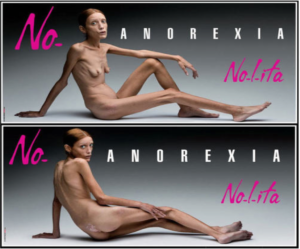
Isabella Caro, billboards by Oliviero Toscani
Isabelle died in January, 2011 at the age of 28. Her weight was 51 lbs. But her last battle for public awareness of anorexia had a positive impact with new restrictions and regulations imposed on fashion industry in attempt to limit its contribution to this new epidemic.
TODAY
Our times have brought many distinctive features reflecting ever changing lifestyles. The concept of beauty became, on a surface, a mix of frequently opposing ideas. Yet each new objective had some representation in the past, each was born from the forefront of forward moving aesthetic ideas.
But, how can we explain the “avant-garde” of today? Is it a spontaneous advancing creation or a pre-meditated provocation with a shock value to amuse today’s profit-first popular culture? Are centuries of the universal attributes of beauty gone for good or just put on hold until another Renaissance ?
On one hand, the present lack of defined parameters of beauty is reflection of boredom, frustration and fascination with media-created celebrities whose mediocrity is obscured by a thick layer of personal conflicts and vanity. On the other hand the amazing world of technology have provided an unprecedented universal access to art, fashion and true and diverse icons of beauty. Yet, for difficult to understand reasons, the vast majority of popular culture is drawn to the first model. Is it because that model does not require contemplation or understanding? Because it has no rules of aesthetics? Or, because it requires only a sreflex response to it’s shock value?
How did we come from universal admiration of sublime aesthetics of Boticelli Venus:
Sandro Boticelli, The Birth of Venus, 1486
to artistically excellent, nevertheless confusing, record breaking commercial value of Freud’s talented grandson?
Lucian Freud, Benefits Supervisor Sleeping
Rapid progress of Aesthetic Medicine and Plastic Surgery begun to play a major role in our desire for physical perfection giving us a chance to emphasize or enhance our natural beauty and follow universally understood definition of classical beauty . And yet, all too frequently, we see something categorically opposite to the intuitive desire for self-improvement. In our search of beauty we fall into the trap set by the “trend setters”, to unrealistic outcomes based on preoccupation with fake images and media hypes. Willingly, perhaps led by curiosity, we begin and end with the adoration and identification with many celebrities, many of those who have very little to offer aesthetically or artistically.
Somehow, we have managed to step away from the roots of natural beauty:
Carla Bruni
and end up with acceptance of fake, distorted and incohesive features:
WHAT’S NEXT?
The Twin Paradox
/in Blog & Updates /by CThe Twin paradox
You are sitting in your surgeon’s office having nice and informative conversation about your upcoming, non-emergency, gallbladder surgery. Near the end of your consultation, you make a special request – you ask the surgeon to make the incision in a shape of a star fish just because you are very attracted to these sweet creatures since childhood. You are not surprised when the doctor politely explains why he must refuse your request.
This kind of response would be expected from any respectable and caring physician who is concerned about your safety and well being rather than perform body modification that could later be questioned on the ethical grounds.
Now, a slightly different scenario. You discuss with your surgeon a face lift you are about to have and request an oversized chin implant plus lips that match your biceps size. In response your doctor gives you several reasons why Saturday is not the best day for surgery.
In both examples the doctor is a surgeon, both have the same number of years in medical school and post-graduate training. In this regard they are twins. Both patients make a very similar request during consultation. And yet, the responses are very different. Why aren’t they a subject to the same expectations? Why unacceptable in the first case becomes a triviality in the second? Sort of a Twin Paradox.
We live in age where nothing seems to shock anymore. We have even accepted the most bizarre products of medicine as a part of our contemporary life. Alien and artificial body modifications are not unusual anymore; we see them on TV, in magazines and on the streets. The shock value indicator has moved down. But, the purpose of this writing is not about our response to these excesses. The question one may ask is Why?
Here are few known examples:
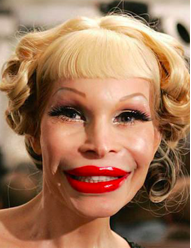





The results of multiple indiscriminate surgeries, implants and filler injections that converted the natural human faces into shapeless masses of soft tissue hanging on the bony structures and “reinforced” by fillers including permanent injectable silicone. Butchery certified!
Here you have two of many examples of “cosmetic” lip enhancements.

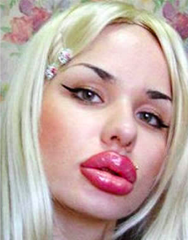
Lip enhancement on industrial scale. Licensed mockery of aesthetics!
Similar examples surround us almost everywhere so it is not easy to find an example that would stand out for its peculiarity. Perhaps this one : it is the case that comes from the most unlikely place, France, where strong aesthetic convictions and natural looks defy any other trends. The case is bizarre for many reasons.
Two highly educated brothers, one with a doctorate in Theoretical Physics, the other with the same degree in Mathematics. In addition to their brilliant minds and scientific work the twins produced a popular science-fiction TV series. Soon, they became a positive, intellectual fixture in French TV pop culture.
Twin brothers Igor and Garish Bogdanoff – popular TV heart-throbs in France
With a passing time, two brothers became interested in “rejuvenation”. At the peak of their great careers, the twins fell in love with Plastic Surgery. After few procedures they became obsessed with progressive modification of their features which, regrettably, found a support in obliging and pragmatic doctors. Multiple surgeries later (the word “surgery” somehow doesn’t fit its intuitive meaning) the good – looking twins morphed into a living mix of Mary Shelley, Robert Louis Stevenson and Toy Story characters.
Igor and Grishka today. Enhanced.
These two brothers, on one hand, intellectually gifted scientists with great careers firmly set in a world full of reason, on the other the slaves to anti-science, anti-aesthetics and fake reality. A Twin Paradox.
One could not overlook the amount of work involved in shaping every inch of these good-looking-no-more faces…a work that does not indicate excessive sense of beauty, profound finesse nor artistic curiosity. And yet, most of the Cosmetic Surgeons consider themselves, and advertize themselves, as professionals with exceptional artistic talents; talents we have a chance to “admire” on TV screens and pages of magazines in long parades of “well- done”celebrities.
What are our most common, instinctive feelings when faced with the “faced to the limit” ? Puffed cheeks, inner-tube lips, extra tight stretched faces with ripples and tension lines, faces that do not indicate even a casual knowledge of human anatomy, motionless faces without detectable expression or thought, faces that look detached from the rest of the body, the faces that give us the impression reminiscent of the first visit to circus, wax museum or budget horror movie. Faces you want to touch to make sure they are real.
What is our first impression when looking at the Bogdnoff twins images? Our immediate and automatic response is to criticize, demean and blame the owners of those humanoid facial alterations. Unfortunately, all too often we do not see far beyond the superficiality. But, is it fair to put the blame squarely on them?
Mind you, the brothers didn’t modify their faces themselves in the privacy of their living-rooms, on Saturday evening, casually listening to the remake of Brahms Lullaby by Eminem while working on the Theory of Everything!. I have a suspicion that a doctor, or perhaps two, more or less famous Cosmetic Surgeons with certified and re-certified skills were involved in the process of “beautification” .
For the sake of fairness, it is the doctor who deserves the bulk of our criticism for crossing the boundaries of the medical profession; a doctor who made a playground out of seriousness of the patient-doctor relationship. We should take an aim also at those who continuously grant them the privilege of being physicians and maintaining their medical license.
The most common response I hear is that patient had requested these modifications so doctor simply obliged. And yet, a surgeon from any other surgical specialty would never, ever, consider patient’s frivolous request out of respect to medical profession, ethics and patients well being. Unfortunately, many Cosmetic surgeons do no subscribe to these professional basics and are allowed to continue their questionable craft.
One more example to make a different point. This time the facial alteration was performed not by a physician but an individual legally licensed to practice body modification, a person who obtained a certification similar to tattoo artists. In this case a custom designed doughnut-shaped implant was inserted under the forehead skin.
Face modification with subcutaneous implants done by a non-physician
The above modification was performed not by a doctor . Is this case any more shocking than the earlier examples of extreme facial distortions created by a licensed and certified doctor who spent years studying medicine, enduring long residencies and fellowship trainings? I submit to you that the “shock value” and aesthetic outcome of both is of the same magnitude! It means, there are only two real possibilities : either this non-physician is extremely talented or the Cosmetic doctor has no talent at all.
Some time ago I was curious about any possible motivations of those physicians who perform medically sanctioned body distortions. I was hoping to find the reasons explaining what could possibly induce a doctor to destroy the innate beauty of human body? What would it take, other than obvious lack of talent, for those who traditionally pride themselves in holding the key to the only remaining artistic and aesthetic aspect of Medicine, to mass produce distortions and ugliness? What instincts could prevail in denying reason?
Going from the basics of human psychology to the deepest and darkest nooks of sociopathic minds and tormented souls, I realized that my search was a time wasted and the answer was too obvious to consider. There are no enigmatic motives behind, no convoluted psychological reasons, no cosmic explanations or artistic arguments to justify creating facial deformities. There is one, and only one, reason. Money! Nothing else but a primordial thirst for money!
Should a medical professional, aka a doctor, be allowed to modify one’s body on-demand? Why the Cosmetic Medicine, as the only subspecialty in the entire field of Medicine, is not held to the same medical and ethical standards of evidence-based and outcome-based medical practice? Should they be allowed to practice their trade without restrictions even though they were granted a license and board certifications? Give me a reason why they should and I will give you ten why they shouldn’t!
You may say I bring up only the worst examples and dismiss many great results of talented Cosmetic practitioners. Granted, there are many wonderful examples of truly artistic surgical hands, yet, if you claim to own the good you must also own the bad. No other way around!
Dr. Kacki recommends optimal skincare products & treatments
/in Blog & Updates /by C
Dr. Kacki’s recommendations for optimal skincare product usage & skincare treatments to
perfect and maintain healthy, youthful skin!
SKINCARE*
THE BEST
- Sunscreen daily
- Tretinoin with or without Hydroquinone daily
- Ascorbic acid (vitamin C) daily
- 5% Glycolic acid daily
- 15% – 20% Glycolic acid every 2-3 weeks
EXCELLENT
- Sunscreen daily
- Tretinoin with or without Hydroquinone daily
- Ascorbic acid daily
- 5% Glycolic acid daily
VERY GOOD
- Sunscreen daily am
- Tretinoin with or without Hydroquinone daily pm
- 15% – 20% Glycolic acid every 3-4 weeks
GOOD
- Sunscreen daily am
- Tretinoin with or without Hydroquinone daily pm
* The choice depends on the degree of sun damage and skin quality
MAINTAINING SKIN QUALITY
12 month program *
THE BEST
1st YEAR
- Micro-needling RF Every 4 weeks x 3
- PRP injection Every 4 weeks x 3
- Microdermabrasion Monthly
MAINTENANCE
- Microneedling RF Every 6 months
- PRP injection Every 6 months
- Microdermabrasion Monthly
EXCELLANT
1st YEAR *
- Micro-needling RF Every 4 weeks x 2
- PRP injection Every 4 weeks x 2
- Microdermabrasion Monthly
MAINTENANCE
- Microneedling RF Every 8 months
- PRP injection Every 8 months
- Microdermabrasion Monthly
VERY GOOD
1st YEAR *
- Micro-needling RF Every 4 weeks x 2
- PRP injection Every 4 weeks x 2
- Microdermabrasion Monthly
MAINTENANCE
- Microneedling RF Every 12 months
- PRP injection Every 12 months
- Microdermabrasion Monthly
GOOD
1st YEAR *
- Micro-needling (pen) Every 4 weeks x 2
- Microdermabrasion Monthly
MAINTENANCE
- Micro-needling (pen) Every 6 months
- Microdermabrasion Monthly
BASIC
1st YEAR *
- Micro-needling (pen) Every 4 weeks x 2
- Microdermabrasion Monthly
MAINTENANCE
- Micro-needling (pen) Every 12 months
- Microdermabrasion Monthly
* The first year choice depends on the degree of sun damage and skin quality
“BEFORE and AFTER” – Believe It or Not?
/in Blog & Updates /by CWithout a doubt, there are many genuine and impressive results achieved by devoted professionals who must often go beyond the standards of protocols to deliver good results. Beyond that, however, I do take issue with those who go out off their way to attract potential customers by using deceptive techniques of imaging. The image manipulations are not very sophisticated and do not necessarily need cooperation of the subjects. Adjusting light conditions, image size, postures, intentional tightening of muscles or similar maneuvers are designed to enhance, convince and deceive.
One could ask whether it is possible to manipulate visual perception to fool the eyes of result seeking public? Is it possible to force mistaken interpretation of what’s appear to be obvious? This question was answered many times over the last several centuries by artists, psychologists as well as by “magicians.”

It is very easy to trick our brain into making an incorrect interpretation of data received from the senses. This misinterpretation of sensory stimulus results in optical illusion.
Optical illusion = Mistaken Judgement
Optical illusion occurs because we don’t always know what we see but we tend to see what we know from experience.
We interpret the above image as two overlapping triangles and three circles even though there are none – only three angles and three incomplete circles. Based on our familiarity with simple shapes and objects our interpretation “adds” missing parts rather than reports the exact picture.
The illusions extend beyond two dimensions; light manipulation allow us to “recognize” relationships in 3D.
Light direction is a cue for 3-D recognition and our perception depends on the choice of concentrating our attention on particular feature. What is concave coud be also seen as convex.
What Light and Shadow can do to our interpretation of reality is frequently mind boggling! Certainly, it could be an entertaining experience but these maneuvers are frequently used as a tool of intentional deception for the purpose beyond entertainment.
On image 1, the fields A and B clearly appear to be of different gray intensity. Image 2 connects both fields revealing our gross misinterpretation!
We must learn to see what is actually in front of our eyes and not what our brain works out for us.
Now, let’s try if our perception of real life examples can be altered and make us see non-existing changes. The following images of “Before” and “After” where obtained by me within several seconds of each other when the only change “in-between” was adjustment of the light direction and intensity.
Now you have it………………………now you don’t!
Naso-labial folds appearance in different light
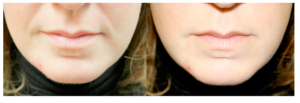
Another “procedure” that erased the naso-labial folds
Here, one can claim that the newest (still imaginary) skin tightening “procedure” can take away even the deepest folds.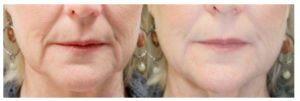
Above, not only wrinkles and folds faded away but the jowls look so much better!
“Dark circles” below the eyes? No problem, we got it covered too. Here are few examples of our expertise.
Dark circles can disappear equally easy with manipulation of light
The “results” appear very convincing to those who are bothered by this common sign of aging and seek a remedy.
Another example of non-existing “rejuvenating procedure”
Are you bothered by cellulite? The latest technology can get rid of your stubborn and unsightly cellulite dimples!
Little light adjustment and…voila!
Patient with common age-unrelated cellulite who may be deeply disappointed with other procedures may be very impressed with the degree of improvement seen on these “Before and After” photographs even though these were made within several seconds of each other.
Near complete “disappearance ” of cellulite
In reality, the above examples come from our office, the VISAGE MedArt in Nashville with full cooperation of our patients. I can assure you that nothing was done between “Before” and “After” images except for the adjustment of light conditions. We did this exercise for educational purpose to help our patients to sort through thousands of images posted on internet.
Below are few similar, random examples from internet; some posted on the websites of the providers and some from marketing pages of the manufacturers of cosmetic devices.
A case of instant cellulite “reduction.”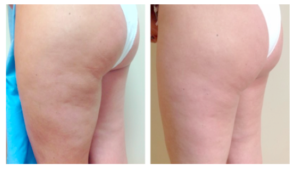
The direction of light in “After” image gives impression of successful treatment of cellulite
“Double chin” can ruin any picture if taken from a wrong angle. Many of us would happily undergo a pricey procedure just to get rid of that extra chin.
A dramatic “reduction” of “double chin”
Actually, nothing is really needed to show these incredible results except a simple chin extension.
Similar results, similar head position, similar claims:
Instant reduction of “double chin” with appropriate positioning
Cellulite and fat “reduction” with…light.
This image, owned and published by Lipotherapeia has even a copyright written all over it. As you can see, the light direction attempts to fool your eye to see a very convincing and impressive results that can not be verified.
One more image from the manufacturer’s marketing portfolio. Whatever the results were, one should question their motives when looking at the extreme difference in light direction.
I am very puzzled by the publication of these images in marketing material. Did the obvious escaped the publisher or they assumed total ignorance of the prospective patients?
It would be either childish or utterly unimaginative to believe that the authors of all these photos are unaware of physical aspects of light perception and illusions it may create. I suggest that the reason is not only an attempt of selling false or exaggerated promises but also patronizing assumption of ignorance of their audience!
I could show endless examples of mistaken perception of images subjected to different light direction or subject’s position. These simple maneuvers are common tools used in marketing to create an illusion of non-existing improvements, giving patients a new hope and, consequently, enticing them to seek the treatment.
I cannot claim much authority for myself, but I think that there is something of a gold standard in ethics
and morality in the conscious mind. To know the difference between what you have right to do and what is right to do is to adhere to the standards of ethical conduct. Condoning this behavior, propagating falsehoods or standing idle is to participate in something that is exactly opposite to the proper conduct in medical profession.
After 27 years in academic and clinical medicine it was not easy to discover that the new direction I have chosen 10 years ago is so dramatically different from medicine I know. It is riddled with deception, arrogance, and self-serving marketing for profit. I feel an obligation to be a patient’s advocate and provide them with arguments that will hopefully help them to distinguish reality from intentional deception.
Dermal Fillers: Synthetic vs Non-Synthetic. The FDA, Ethics and Money
/in Blog & Updates /by CPART I of IV
VISAGE MedArt is an ambassador, full on supporter of many, natural, bio-degradable DERMAL FILLERS (facial volume enhancers) currently on the market. Dermal Fillers have been used around the world for over two decades with continuous annual growth of injection procedures. Filler injections have become THE most popular non-invasive cosmetic procedure in the U.S., surpassing Botox injections. More patients have incorporated fillers into their routine for beauty maintenance, and more and more articles on this subject appear in popular magazines giving them wide public exposure, including the under-age population.
I want any person interested in dermal filler injections to have adequate information about the safe and unsafe options available when considering this type of periodic enhancement. The diversity among dermal fillers on the global market is profound. We encourage patients to pause, ask, learn and understand.
Not only the public but also a high percentage of physicians are unaware of the safety profile of many injectables . Neither the FDA, medical literature nor beauty magazines provide adequate information concerning the problematic nature of certain synthetic fillers. The popular magazines, including fashion and beauty publications, can tend to stay away from any negative views regarding cosmetic procedures. After all, many of the advertisers from the beauty industry use their pages to glorify their products. There is no financial gain to making consumers fully educated.
How about the doctors? The medical cosmetic literature directed toward cosmetic physicians and surgeons is a problem in itself. The articles are largely written by doctors who are supported by Big Pharma; the majority of the “studies”are sponsored and financed by the same, Big Pharma. Not surprisingly, there is very little written about the possible adverse reactions and long term consequences of some synthetic fillers on the market making the perception of safety, unquestioned.
Interestingly, it is quite the opposite in some countries that have a much longer history using these products. In the United Kingdom numerous reports have been published in their medical literature describing, and criticising specific fillers, many of which have left patients with permanent, lifelong disfigurement.
Almost 70% of Britain’s Plastic Surgeons have reported encounters with patients suffering with problems resulting from certain dermal fillers. 50% of surgeons reported seeing patients with more serious complications from permanent or semi-permanent fillers of which more than three quarters either required corrective surgery or were untreatable due to permanent damage.
And yet, with very few occasional exceptions, the negative reports are invisible in our country; any discussion forum that involves patients and doctors, including well known consumer websites not only avoids negative comments but has become an easy market for self promotion, glorification of fake beauty and intentional propagation of marketed products. NEXT: The Importance of Injection Technique
PART II of IV
The Importance of Injection Technique
The technique of filler injections places a key role in achieving the most desirable results. It is also instrumental in avoiding many serious complications.
A real breakthrough came in 2007 in France with the first use of the flexible cannula for injections. By its specific design, with no sharp or cutting edges, the flexible cannulas allow easy movements within the tissue without cutting or penetrating blood vessels. These characteristics should minimize or eliminate significant bruising or bleeding and avoid the under-reported, sometimes devastating, complications. In extreme cases there can be permanent blindness or tissue necrosis/gangrene. VISAGE MedArt incorporated cannulas into our practice the following year, 2008 when the technique was embraced around the world and has become the gold standard for dermal filler injections. Unfortunately, it still remains a rarity in the US. Yes, it does increase the cost to medical offices in the way of cost of the supplies; and yes, it can make the procedure a little longer. But at VISAGE we feel strongly that the patient’s safety is worth the few extra dollars and possibly one less time consuming appointment.
But even using needles for injection can be safer and less traumatic; it only requires the understanding of a few principles of physics. The original needles included in each filler package are quite large with an extensive total cutting edge that is beveled, causing unnecessary trauma. Using smaller needles is, however, impossible with the designed and re-designed filler syringes. The only option is to transfer filler to a different syringe with optimal physical properties that allows for a smooth injection of even the thickest filler while using a tiny needle. It adds minimal cost and time to the procedure but minimizing unintentional complications is more than worth it.
Reactions to Fillers
While injection techniques improves patient safety an important thing to consider is “what is going on IN the tissue once the filler is injected”? Certain synthetic fillers are well known to induce immunologic/allergic reactions to the injected areas. Whenever a reaction occurs, the response may lead to formation of large lumps that may, over time, result in facial deformity.
In some very unfortunate circumstances, the popularity of dermal fillers for facial injections has lead to rather careless and irresponsible FDA’s approvals of several injectable agents that were well known to cause severe side effects .
Silicone
Silicone, the permanent filler, receiving blessing from the FDA and embraced by many doctors, had caused so many serious health and aesthetic problems that the Justice Department filed injunctions against certain physicians on behalf of the…..FDA, the same agency that piously portraits itself as a guardian of safety.
“U.S. Food and Drug Administration, assures purity, safety, and accessibility, as well as much-needed information regarding use.”
Big Pharma prompted the FDA approval of synthetic agents (Silicone being one) that should have never reached the market nor be used by doctors. A dangerous pattern has eroded the system where politics and money in the field of aesthetics became a guiding force at the expense of the consumer’s safety.
PART III of IV
Artecoll or Artefill?
The synthetic non-absorbable fillers can not be “digested” by the human immune system. It will force a chain reaction, leading to isolation of the particles and formation of inflammatory nodules that must be removed, usually by surgical intervention.
One such product that was approved was Artefill also known as Artecoll. The key components of Artefill-Artecoll are small, synthetic, polymethylmethacrylate spherical beads. Injections of this product had been known to be associated with scarring, and disfigurement that requires correction by surgery or, in less severe cases, by repeated injections of steroids and other potent medications.
Artecoll, the predecessor of Artefill, was removed from the list of fillers in Canada as well as Germany and Switzerland. Those countries advised physicians not to use this product and not to subject their patients to unnecessary and potentially harmful side effects.
Prior to the release of the Artefill in the USA, a senior member of the FDA was contacted with several articles related the negative experience with Artecoll in other countries. Although the evidence was overwhelming it was arrogantly ignored and the Artefill was released and recommended by many doctors who were either unaware of the problem or ignored the experience of others.
Then, with more reports of side effects, came the article in the Wall Street Journal revealing to the public the previously undisclosed safety issues and a long list of adverse reactions reported from abroad. Although the publication of the article brought down the manufacturer of Artecoll with subsequent bankruptcy, one would be naive to think it was the end of Artecoll/Artefill.
Suneva Medical Inc. San Diego, CA has brought this product back to the market and, predictably, numerous adverse reactions have followed.
As a physician, I know from my own experience that pharmaceutical companies cannot be relied upon to report adverse events , yet the FDA proclaims it can assess adverse reactions by relying on doctors and “Big Pharma” to report these directly to the FDA!
Changing the name of the product from Artecoll to Artefill , could not change its history or adverse reactions seen in the past. In many published articles, the “experts”, “consultants” and “luminaries” have been using these two names interchangeably adding to the confusion. How is it possible that Artefill received FDA approval as a “new” product if presented studies were that on Artecoll?
I can not resist but to repeat the quote:
“U.S. Food and Drug Administration, assures purity, safety, and accessibility, as well as much-needed information regarding use.”
Sculptra
Sculptra had received the initial FDA approval for treatment of HIV-associated facial lipoatrophy, a disturbing medication-related fat loss in the face. It has been now approved for individuals without HIV who are seeking cosmetic enhancement.
Sculptra is an injectable agent that apparently induces the formation of new collagen. However the FDA has never evaluated the filler’s effect after implantation; the biopsies of the injected area were omitted in FDA’s “strict” approval process!
Contrary to what the manufacturer suggests, it is an “immunologic foreign body reaction” that is noted on biopsies performed later in order to diagnose etiology of the side effects. It is the reaction that will, on many occasions, provide the filling effect and volume restoration but it may also result in lumps and nodule formation.
In the initial studies on Sculptra on HIV-related facial fat loss the nodules were visible and palpable in many patients. For example, in VEGA study exactly 52% of patients treated with Sculptra developed visible nodules; in the C & W study, injection of Sculptra resulted in the same complication in 31 percent of individuals ! Large nodules have been seen above the lips, in the cheeks, under the eye and in other sites of injections.
To make the process even more cynical one should look into the study considered by the FDA to be sufficient for approval of Sculptra for general use. The study was conducted by the team in which every single investigator was a paid consultant for the manufacturer of Sculptra! Of course, as before, no biopsies were included! Extremely high incidence of side effects as seen in VEGA and C & W studies was ignored and considered irrelevant.
The examples cited above indicate how inadequately cosmetic devices are evaluated by the FDA prior to their release.
As in the case of Artecoll and Artefill, the complications of Sculptra implantation were well known and published in the European medical publications prior to its approval in the USA . These side effects included infections, granuloma formation (tender nodules) and long term allergic reactions. Since these reactions are reportable, the FDA must have been well aware of their existence prior to Sculptra’s approval!
PART IV
“U.S. Food and Drug Administration, assures purity, safety, and accessibility, as well as much-needed information regarding use.” My personal suggestion to all who consider filler injections is to stay cautious, read as much as possible using unrelated sources of information, educate yourself and ask questions until you are satisfied. Unfortunately, much of Medicine has become business, including Aesthetic Medicine. While some business’ do not recognize sentiments or human relationships beyond business , the role of every physician is to act first and foremost in the best interest of their patients rather than taking on the role of a salesperson. Ethical engagement between the practitioner and the user of cosmetic procedures cannot be reduced simply to the question of informed consent. Doctors must recognise the limits of their own competence not only related to their skills but also with reference to understanding the motivation for their recommendations. Even if the definition of ethics becomes corrupted or becomes a matter for convenient interpretation, the meaning of ethics should not and cannot be changed.
Dermal Fillers – What, Where, Why and How? The VISAGE difference
/in Blog & Updates /by CThere are about 14 dermal fillers of non-animal origin available in the US yet there are over 200 fillers in use around the World. Many of unavailable to us fillers are from the makers of our Juvederm, Restylane and Radiesse.
The Galderma’s Restylane line is 27 products-long but we have only 5; Allergan, the company behind the Juvederm line, makes as many as 16 products abroad with only 6 here.
Since each FDA approved fillers have a specific indications, the majority of them are not really related to their original intended use but to aesthetically and medically irrelevant factor – the availability.
Therefore, most of the fillers we use are only relatively indicated for approved applications making the term “off-label” nearly obsolete.
The problem of FDA approvals is not only an administrative issue but, more importantly, an ethical dilemma of high magnitude! (more details in next blog entry).
Is there an advantage of having more products to choose from? Yes, and No.
No, because in reality one could do almost everything that is considered a “standard” with just few products.
Yes. Having more options gives us wider range of intricate possibilities from simple skin hydration, nourishment and rejuvenation to treatment of large volume deficits. More choice you have, more minute details can be addressed the more likely you will find a filler that will be optimal for your own specific needs, that may last longer, be more compliant with skin movement and stretching or will provide your skin with additional benefits such as the antioxidants and/or vitamins.
Difference between the fillers
Over 95% of all dermal fillers are made of hyaluronic acid, a natural component of our skin that makes it “springy” and “plump”. Hyaluronic acid in filler is capable of easy tissue integration, attracting and binding water to expand and provide volume .
The non-hyaluronic acid fillers are composed of various ingredients with Radiesse being the most attractive and safest option. The permanent or semi-permanent fillers are not advisable due to their known long-term inflammatory response, tender nodules and irreversible disfigurement.
These very controversial and unpredictable fillers were removed from the markets in many countries including Canada. They should not be used or offered to patients without a full disclosure of their history and potential harmful effects.
Hyaluronic Acid Fillers
The hyaluronic acid fillers differ in concentration and the level of bonding between the molecules. In general, thicker fillers last longer and should be implanted in much deeper plane to replace volume while fillers designed to correct more superficial structures are thinner and have shorter longevity.
The available hyaluronic acid fillers includes:
Juvederm Line – Juvederm Ultra, Juvederm Ultra Plus, Juvederm Voluma, Juvederm Volbella, Juvederm Vollure
Restylane Line – Restylane L, Restylane Lyft, Restylane Silk, Restylane Defyne, Restylane Refyne,
Belotero Line – Belotero is only one of many available from this line.
For large volume losses, cheeks, chin, temples and jaw re-contouring – Juvederm Voluma, Radiesse or Restylane Lyft are the best options.
For lips – Juvederm Ultra, Juvederm Ultra Plus, Juvederm Volbella or Belotero are most frequently used.
The “tear troughs” are much more demanding and challenging. It has been known for some time that many hyaluronic acid fillers can induce an unpredictable reaction with swelling, frequently occurring months after the injection and not always in all injected areas. The true mechanism of this side effect is still poorly understood with theories ranging from excessive water retention to partial blockage of the lymph outflow. This side effect is frequently associated with Juvederm line of products. The safest of the available fillers for “tear troughs” are Restylane or Belotero.
In practice, the assigned indications for the hyaluronic acid fillers are not absolute. If longevity of the “lip filler” is disappointing one should consider longer lasting Restylane Lyft or Juvederm Voluma .
Strict adherence to approved indications eliminates many great options and, in a long run, could be much more expensive.
Non-Hyaluronic Acid Fillers
There are 4 non-hyaluronic acid fillers available in the US: Radiesse, Sculptra, Artefill and the newest product – Allofill.
Radiesse is made of Calcium Hydroxylapatite, a substance similar to the matrix of our bones. It is quite viscous and is best used for deep injections and larger volume replacement. The major ingredient works by stimulating local production of new collagen which, in time, adds volume to the injected area. It is fully reabsorbable but not dissolvable. Radiesse can be implanted in nearly any area except for lips.
Sculptra, chemically a Poly-L-Lactic Acid, was initially approved for treatment of facial lipoatrophy, a troubling side effect of anti-retroviral therapy. It is assumed that the ingredient is stimulating production of new collagen. As opposed to all other fillers, the results are not visible immediately but it takes few months for collagen to accumulate .
Few years ago, Sculptra received additional FDA approval for all aesthetic indications even though its side effects were known from its previous use.
Allofill, the newest product, deserves a special introduction – the subject of the next blog. Briefly, it is the most natural of all fillers that is derived from fat tissue obtained from donors. This is the only filler with potential to remain in place for years.
By far, the most common question related to fillers is: “How long does it last?”
In all honesty, there is no answer to this question and if you believe the marketing you have a good chance of being disappointed. There are many factors that may change the lifespan of every filler, many of them are unknown, others may even defy logic.
In general, thicker fillers last longer. The level of activity and your own basic metabolism will affect the longevity of many fillers, sun exposure may shorten the effect of Radiesse while thyroid disfunction can alter the process of filler degradation. There is always a possibility that certain medications or supplements could contribute to filler’s duration.
Technique
The technique of filler injection is one of the most critical issues in successful aesthetic enhancement. The standard techniques of injections as well as post-injection handling of tissue may have significant effect on the outcome. The depth of injection will impact filler duration, injection in one area may influence the effect in remote areas and excessive and inappropriate “massaging” or “molding” is known to shorten filler’s lifespan.
The effect of filler placement that is most frequently neglected is a subject to physical laws for liquids. It was elegantly displayed in the work of Wayne Carrey, M from the McGill University in Montreal. His proposed unusual technique of injection results not only in spectacular sculpting of the upper face, cheeks and under-eye area but has achieved significantly longer durability of the fillers reaching, in some cases, up to 5 years!.
As ingenious as it is, only very few are familiar here with this technique and even fewer are skilled enough to perform it. The reason is that the injection trainers from the manufacturers are mostly unaware of it nor will discuss the technique that could potentially decrease the frequency of injections. It is not difficult to guess why?
VISAGE difference.
What do we do differently at VISAGE? Nearly everything! First, our filler recommendations are not based on their indications but on particular circumstances including history of previous use. Personally, I almost never use the syringes or needles supplied by the manufacturers which, by the way, were redesigned few times due to their inherited flaws. Because of their physical characteristics, the syringes preclude the use of the smallest needles; the needles provided in each package are relatively large bore causing unnecessary trauma. Therefore, we transfer fillers to a different syringes that, based on laws of physics, are much more effective when used with small needles.
In 2007, the first flexible cannula for filler injection was introduced in France. It added great versatility to the technique of injection and, more importantly, have nearly eliminated the most severe, sometimes devastating, complications of needle injection. We begun using cannulas in 2008, long before the device became available on the market.
Even though the introduction of cannula 10 years ago have eliminated many safety concerns and was widely accepted around the world, it remains a relative rarity in the US. The reasons are few: the cost of disposable cannulas and lack of knowledgeable trainers. The manufacturers of fillers offer rather basic injection courses and only for needle injections. It is difficult to understand why Allergen, the maker of Judder Volume, does not teach cannula injections in this country when the same product in Canada and other countries contains cannula in the package!
We suggest particular fillers for less common injection sites, use micro-injections and, on occasion we may mix different fillers in order to achieve particular aesthetic goals. Our injection process is nearly always little longer; it allows us to pay attention to every detail and…enjoy conversations, frequently unrelated!
Each injection is a separate project that requires attention and judgement. Regardless of the technique, the key is injector’s artistic imagination, the ability to see the final outcome before it begins. Every single injection point brings effect that must be seen in the context of totality. The reference and injection points reside only in imagination but must not be random. The outcome of unimaginative injection is always predictably bad – fish or duck lips, overblown cheeks, loss of proportions and fake appearance. It takes more than knowledge of anatomy and ability to empty the syringe. It takes something that can not be mastered by reading a textbooks – the ability to use artistic perception, judgement and incorporate them into dexterity.
And, on occasion, to say “no”.
Platelets and Process of Rejuvenation and Tissue Repair
/in Blog & Updates /by CPlatelets and Process of Rejuvenation and Tissue Repair
Platelets, one of three major blood cells, play a key role in natural process of repair, healing and rejuvenation of damaged tissue. The entire process occurs over time by utilizing effects of several factors contained in platelets.
To make it understandable here is the most simplified explanation: a damaged tissue (whether damaged by sun, physical trauma, burn, heart attack or stroke) sends a signal to the rest of your body that help is needed to rescue the area. Many different cells participating in tissue repair, from nearby cells to those circulating in blood, receive the signal and begin aggregating at the site of damage. One of the most important are the platelets, a normal constituent of our blood. Platelets aggregate in damaged area and release the “healing” factors that begin process of reparation. The process is quite long since your body can only bring a limited number of platelets to the damaged site.
PRP is a process of concentrating platelets obtained from your own blood. It requires blood to be span down in a special centrifuge, preferably twice, with red blood cells and white blood cells being discarded. What’s left are very concentrated platelets that are injected to the site of damage. The concentration of platelets in PRP is several times higher than what body can deliver. By enhancing the body’s natural healing capacity, PRP injection leads to a rapid, efficient, and thorough restoration of tissue to its healthy state.
The concentrated platelets contain numerous factors participating in healing, repair, tissue rejuvenation and attracting stem cells to the area of injury. These “healing” factors stimulate proliferation of mesenchymal cells, stimulate extracellular matrix production, including collagen, and increase angiogenesis (formation of new blood vessels) allowing rapid healing of injuries.
Platelet-rich plasma (PRP) therapy has become the ultimate biological treatment for injuries in Sport Medicine , Orthopedic, Cardiovascular Surgery, Oral Surgery and in Veterinary Medicine. Although PRP has made its entry to the Aesthetic Medicine relatively late it has quickly become one of the most effective procedures in skin rejuvenation.
Two major indications for use PRP in Aesthetic Medicine are skin rejuvenation, hair restoration and to extend the longevity of dermal fillers.
The process involves drawing 2 small tubes of blood and spinning them at the very high centrifugal forces. At the Visage, we spin the blood twice, each time discarding unnecessary components. Once the process is completed the remaining concentrated platelets are transferred to syringes and are ready for injection.
The injections may involve either the areas of concern only or the entire face. Numerous injections, mostly superficial, are spaced 1/2 – 1/3 inches apart.
Following the injections, there is no specific aftercare and you may return to your normal daily activities. The process of rejuvenation has begun
Frequency of PRP injections
How often to have the PRP injections to achieve the best results depends on the condition of your skin. On average, 4 sessions every 4-6 weeks are optimal with maintenance injections every 8 – 12 months. This method provides the best long term results with no downtime and is apreferred rejuvenation technique for active individuals as well as the celebrities; it has replaced the majority of more aggressive rejuvenation procedure such as the CO2 laser resurfacing.
If the skin sustained a significant chronic sun damage associated with extensive wrinkling and laxity, the PRP injections can be used together with topical application during aggressive micro-needling.
In summary, PRP has become one of very few aesthetic procedures that provides universal benefits to anyone interested in skin rejuvenation. It is 100% natural, does not have any contraindications and no downtime
CONTACT VISAGE
Phone: 615.646.9770
Fax: 615.646.9792
Email: [email protected]
Address
359 Clofton Drive
Nashville, TN 37221
Operating Hours:
Tuesday – Thursday 10am – 3pm
Extended hours available by appointment.
Holiday hours may vary

